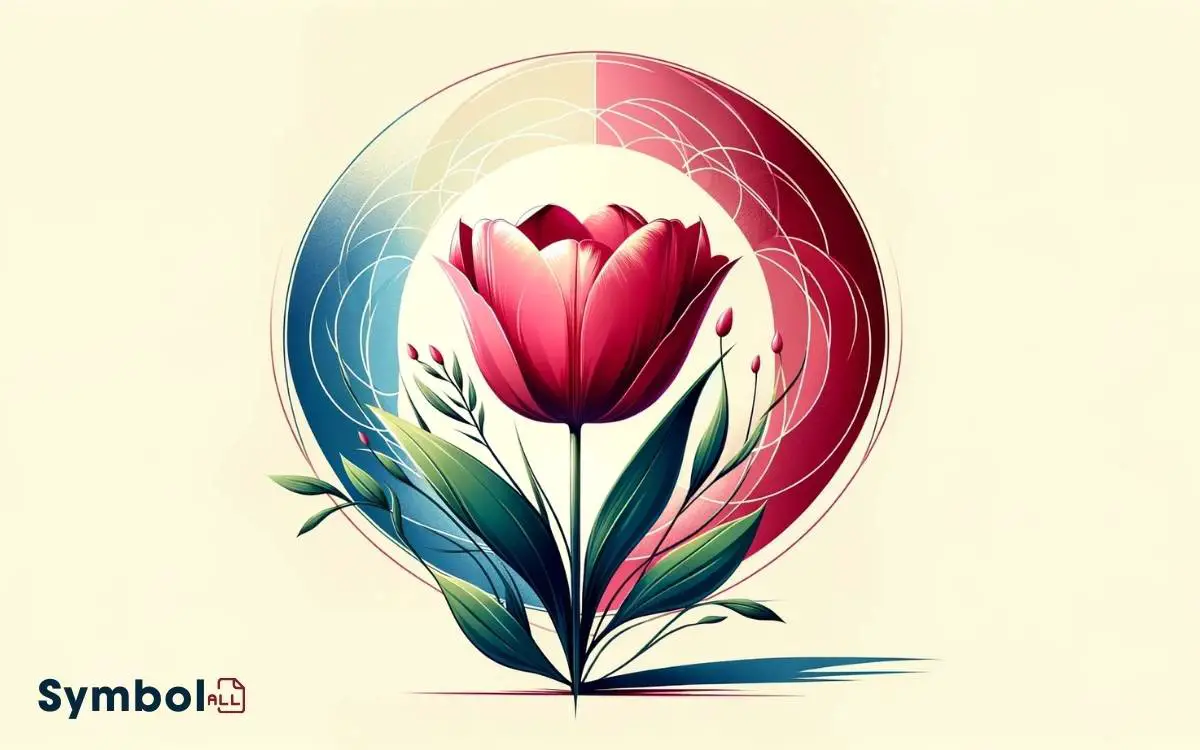What Does Tulip Flower Symbolize? Love, Wealth!
Tulips aren’t just splashes of color; they’re messengers of emotions and history. Originating from Central Asia and Turkey, they whisper tales of love, wealth, and renewal. Imagine, a red tulip in your hands symbolizes deep, undying love, while a white one speaks of pure intentions.
A vibrant yellow tulip beams cheerful thoughts, brightening your day. They’ve marked economic prosperity, becoming symbols of abundance in the Dutch Golden Age.
Beyond their beauty, tulips embody the cycle of renewal, nodding to personal growth and the joy of new beginnings.
Let these flowers take you on a journey of discovery, where each hue tells a story of emotions, history, and transformation.

Key Takeaways
The Origins of Tulips
Tracing back to the wind-blown mountains of Central Asia, tulips set off on their remarkable journey, enchanting hearts as they spread across the globe.
You’d be fascinated to know that these vibrant blooms, bursting with color, were once wild flowers, thriving in the harsh climates of Turkey and Persia. It was there, amidst ancient civilizations, that tulips began to symbolize abundance and indulgence.
Their journey from the rugged terrains to becoming a coveted gem in the gardens of the Ottoman Empire is nothing short of extraordinary. Botanists and travelers, mesmerized by their beauty, carried tulip bulbs across continents.
As they reached Europe in the 16th century, their popularity soared, turning them into a symbol of wealth and status among the elite.
Tulips and Perfect Love
Beyond their historical significance and beauty, tulips have come to symbolize perfect love, capturing hearts with their delicate form and vibrant colors.
These enchanting flowers, with their smooth petals and elegant posture, whisper tales of undying affection and harmonious relationships.
Each bloom stands as a validation to an enduring bond, embodying the essence of a love that’s both pure and deep. The way tulips bend towards the light mirrors how love gravitates towards warmth and growth, showcasing a resilience and adaptability in the face of life’s challenges.
They remind you that perfect love isn’t just about the grand gestures, but also the subtle moments of beauty and strength shared between souls, making them a favorite for expressing love that’s as enduring as it’s beautiful.
Color Meanings in Tulips
As you explore the vibrant world of tulips, you’ll find that each color carries its own secret message.
Red tulips whisper tales of deep love, igniting hearts with their passionate hue, while white tulips symbolize pure intentions, offering a canvas of sincerity.
Yellow tulips, bursting with joy, send cheerful thoughts, brightening days with their sunny disposition.
Red Tulips: Deep Love
Red tulips stand as vibrant symbols of deep love, embodying passionate emotions and heartfelt commitments with their rich, crimson hues. When you give someone red tulips, you’re not just giving a bouquet; you’re sending a powerful message of your deep, abiding love.
This tradition of gifting red tulips has roots that are as deep and enduring as the emotions they represent.
Here’s why red tulips are the perfect expression of love:
- Intensity: Their vivid color mirrors the intensity of your feelings.
- Endurance: Like true love, they stand resilient and beautiful.
- Uniqueness: Each bloom is a unique expression of affection.
- Tradition: They carry a timeless tradition of love and passion.
Understanding these symbols enriches your gestures, making them more meaningful and poignant.
White Tulips: Pure Intentions
White tulips, with their serene and pristine petals, symbolize the purity of your intentions and the sincerity of your heart when you choose them as a gift. These flowers aren’t just a token; they’re a deeply meaningful gesture, transcending mere words.
Each white tulip stands as a beacon of honesty, offering a whisper of genuine affection and respect. In the language of flowers, gifting someone white tulips is akin to saying, ‘My feelings for you’re pure and true.’
They embody a perfect balance of elegance and simplicity, making them ideal for expressing heartfelt emotions without the need for grandeur.
Yellow Tulips: Cheerful Thoughts
Basking in the warm glow of yellow tulips, you’re instantly enveloped in their radiance, symbolizing joy and good cheer.
These vibrant blooms carry a message of happiness and hope, making them perfect for lifting spirits and brightening days. But what exactly makes yellow tulips so special?
- Sunshine Embodied: They represent the sun’s warmth, bringing light into lives with their bright hues.
- Symbol of Friendship: Yellow tulips are often given to express caring thoughts and platonic love, strengthening bonds.
- A Sign of Hope: In moments of despair, they serve as a reminder that there’s always light after darkness.
- Cheerful Thoughts: Gifting yellow tulips conveys wishes for happiness and a joyful life ahead, making them ideal for celebrating new beginnings and achievements.
With such profound meanings, it’s no wonder yellow tulips are cherished worldwide.
Tulips in Historical Events
Throughout history, tulips have played a pivotal role in various cultural and economic events, symbolizing both prosperity and, at times, cautionary tales of excess.
You’ll find these vibrant flowers at the heart of the Dutch Golden Age, where they weren’t just a symbol of wealth but also a subject of the world’s first speculative bubble, known as ‘Tulip Mania.’
During this period, the value of certain tulip bulbs soared beyond the price of luxury homes, only to crash dramatically, serving as a lesson on the dangers of speculation.
Beyond economics, tulips have also been significant in diplomacy, often gifted as a sign of goodwill between nations.
Their presence in historical events underscores their enduring allure and the complex layers of meaning they’ve carried through the ages.
Prosperity and Abundance
As you explore the vibrant world of tulips, you’ll discover their deep-rooted symbolism in prosperity and abundance.
These flowers aren’t just a feast for the eyes; they’ve historically been a marker of wealth growth and have held significant associations with economic prosperity across various cultures.
Today, tulips continue to play a pivotal role in the modern economy, embodying the enduring link between beauty and wealth.
Wealth Growth Symbolism
The tulip, often heralded as a symbol of wealth growth, embodies the essence of prosperity and abundance, inviting you to embrace its rich symbolism in your life.
Delving into the myriad hues of tulips, each color whispers tales of wealth and success, urging you to listen closely and let these blossoms guide your path toward financial prosperity.
Here’s how tulips can inspire you:
- Bloom with Confidence: Just as tulips stand tall, they encourage you to hold your head high amidst financial uncertainties.
- Embrace Change: Tulips’ growth from bulbs to vibrant flowers symbolizes the evolution of your wealth over time.
- Renewal and Hope: Their annual rebirth serves as a reminder that opportunities for wealth are always budding.
- Diverse Investments: The variety in tulip colors teaches the importance of diversifying your assets for steady growth.
Let these lessons from the tulip inspire your journey towards a prosperous future.
Historical Wealth Associations
Building on the symbolism of tulips in manifesting wealth, let’s explore their deep-rooted historical associations with prosperity and abundance that stretch back centuries.
Originating from the Ottoman Empire, tulips weren’t merely flowers; they were symbols of divine blessing, representing the heaven on earth and the opulence of the empire.
As these enchanting blooms made their way to Europe, particularly the Netherlands, their value skyrocketed, leading to the infamous ‘Tulip Mania‘ of the 17th century.
This period, where tulips were traded for the price of luxurious houses, underscores their embodiment of wealth and extravagance. Their vivid colors and rare varieties became synonymous with social status, showcasing one’s affluence.
The tulip’s journey through history is a confirmation of its enduring symbol of prosperity and abundance.
Tulips in Modern Economy
Entering into the modern era, tulips continue to symbolize prosperity and abundance, now playing a substantial role in economies around the world. Your fascination with these vibrant blooms isn’t just about their beauty; it’s also about their economic impact.
Here’s why:
- Global Trade: Tulips are a major horticultural export, fueling international trade and contributing significantly to national economies, especially in the Netherlands.
- Tourism Attraction: Tulip festivals attract visitors worldwide, boosting local economies through tourism.
- Innovative Agriculture: Advanced breeding techniques have transformed tulip cultivation, making it a symbol of agricultural innovation and sustainability.
- Cultural Influence: Their economic importance has made tulips a cultural icon, influencing art, design, and festivals, further cementing their role in the economy.
This depth of influence showcases the tulip’s enduring legacy as a symbol of prosperity and abundance.
Tulips: A Symbol of Renewal
Spring’s arrival breathes new life into the earth, and tulips, embodying this rejuvenation, stand as vibrant harbingers of renewal.
As you wander through gardens awakening from winter’s slumber, you’ll notice tulips pushing through the thawing soil, excited to announce the season’s change.
Their presence is a proof of nature’s cycle of rebirth and growth. Each tulip color whispers its own story of renewal: red for love reborn, yellow for bright beginnings, and purple for royalty rediscovered.
These flowers don’t just symbolize the earth’s physical renewal; they’re a metaphor for personal growth and new starts.
Embrace the message tulips offer; let them inspire you to shed the old and welcome the fresh possibilities blossoming around you.
The Dark Side of Tulip Symbolism
Beneath its vibrant allure, the tulip also harbors a lesser-known narrative, steeped in history and tinged with caution. This flower, while a symbol of love and beauty, carries with it stories of obsession, economic collapse, and a warning against vanity.
Let’s explore further:
- Tulip Mania: The first recorded speculative bubble, where prices for tulip bulbs reached astronomically high levels, ultimately crashing and causing financial ruin for many.
- Fleeting Beauty: Symbolizes the transient nature of wealth and happiness, reminding us of the dangers of superficial pursuits.
- Obsession: Tales of individuals consumed by their desire for the rarest tulips, leading to personal downfall.
- Vanity Warning: Serves as a historical lesson on the perils of vanity and greed, echoing through time to caution against similar follies.
Tulips in Art and Literature
Moving beyond the dark tales of obsession and economic turmoil, tulips have also left a vibrant mark on the canvas of art and the pages of literature, embodying themes of beauty, impermanence, and human emotion.
In the golden age of Dutch painting, artists like Judith Leyster and Jan van Huysum immortalized tulips, capturing their delicate form and vivid colors, symbolizing wealth and the fleeting nature of life.
Literary works, from Shakespeare’s sonnets to contemporary poetry, often reference tulips as metaphors for deep love, renewal, or sorrow. These blooms inspire a myriad of emotions, serving as muses to creators who explore the complexities of existence.
You’ll find tulips intricately woven into narratives, where they’re more than mere background—they’re pivotal symbols, enriching tales with their layered meanings.
Tulips Around the World
As you journey across the globe, you’ll discover that tulips are celebrated in a myriad of cultures, each attributing its own unique symbolism and significance to these vibrant blossoms.
These enchanting flowers hold a special place in the hearts of many, and here’s why:
- The Netherlands: Renowned for their vast, colorful tulip fields, the Dutch regard tulips as symbols of spring and renewal.
- Turkey: Originating from the Ottoman Empire, tulips represent paradise on earth, embodying perfection and abundance.
- Iran: Tulips symbolize the redness of martyrs and the joy of paradise, deeply rooted in Persian culture.
- China: Here, tulips are cherished for bringing prosperity and harmony, often given as gifts during the Lunar New Year.
Each culture’s unique perspective enriches the global tapestry of tulip symbolism, weaving a story of beauty, resilience, and renewal that resonates worldwide.
Conclusion
In the tapestry of symbolism, tulips are more than mere blooms; they’re whispers of history and harbingers of love, weaving tales of prosperity, renewal, and even caution.
From the vibrant hues that paint love’s many shades to the dark tales that caution against greed, tulips encapsulate the complexity of human emotion and experience.
As you marvel at their beauty, remember, they’re not just flowers; they’re storied sentinels of our deepest desires, guiding us through the seasons of life.






